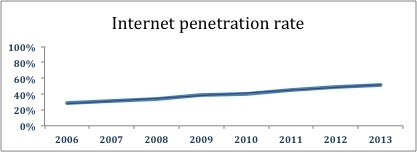Internet penetration in Brazil has been growing steadily for the past years, a success worth celebrating. However, with the advent of the mobile Internet, adoption now lags well behind availability for reasons that are important to understand.
From 2006 to 2013 the compound annual growth rate (CAGR) for Internet penetration was 9 percent. This figure highlights two important trends: first that the Internet has become much more accessible, and second that a large part of the Brazilian population has quickly adopted the Internet. For 2013, there were more than 103 million Brazilians using the Internet, which represents 51.6 percent of the country’s population.

Figure 1 . Source ITU (2014)
However, although the growth on Internet usage has been rapid, there is still a large part of the population that has never accessed the Internet. In order to address this gap, it is important first to understand its source. The first area one would look is whether Internet access is available to those who wish to access it. The following chart shows that availability is largely not an issue. Thanks to the widespread availability of mobile, almost 90% of Brazilians had access to the mobile Internet by 2013, far greater than the 52% who were using the Internet.

Figure 2 . Source ITU (2014)
The explanation for the gap between the availability of mobile Internet and adoption might be affordability – the cost might put Internet access out of reach of many. However, here again recent evidence is encouraging. Based on the numbers available for 2013, the cost of mobile broadband was 3.23% of average per capita income, well below the maximum threshold rate of 5% put forward by the ITU Broadband Commission on Digital Development. Fixed broadband, at a cost of 1.42% of average per capita income, is yet more affordable where available.
To learn what the main barriers to Internet adoption are if not availability and affordability, we turn to an annual ICT survey carried out by the Regional Center for Studies on the Development of the Information Society (CETIC) in Brazil. This is an invaluable and rare resource, not just because it has been repeated yearly since 2006, but also because it asks individuals and households who are not on the Internet for their reasons.
The following chart tracks the main reasons that non-Internet users gave from 2007 to 2013 – individuals could choose as many reasons as were relevant to them. The results confirmed, in particular, that availability and affordability were not significant issues, as only one-quarter of non-users gave those as reasons. On the other hand, 70% cited a lack of need or interest and 70% also cited a lack of skills, as significant reasons.

Figure 3 . Source CETIC Brazil (2014)
This suggests a key area of focus for stakeholders seeking to increase adoption should be to focus on the demand-side – to provide relevant local content to interest non-users and training to enable them to get online. The supply-side issues – availability and affordability of access – are still important, but secondary, according to the survey results.
However, it is worth keeping in mind that the survey numbers in Figure 3 are not representative of the entire population, but represent the reasons cited by an ever-decreasing pool of non-Internet users. As shown by the black line in the graph below, the number of users in the survey who have not used the Internet was steadily decreasing. Thus, while 70% of non-users cited a lack of need or interest as a reason for not using the Internet in 2013, that represents about 29% of the population, a trend which has been fairly stable over time. The same is largely true for the other main trends.

Figure 4 . Source CETIC Brazil (2014)
As a result, it is important to focus efforts on this persistent minority of Brazilians who are not swayed by increased availability or lower costs. Delving further into the data, it appears that, within the group citing a lack of need or interest, there is relatively little difference by region, gender, education level, and income. The only factor for which there are significant differences is based on age group, where only 27% of 10-15 years cite a lack of need or interest as a reason not to adopt, while 81% of those over 60 cite that as a reason. For the other factors, there are even less differentiators across the various groups.

Figure 5 . Source CETIC Brazil (2014)
The conclusions drawn from this information are clear. As more users are covered by mobile Internet access, availability and affordability play less of a role in the decision not to adopt the Internet. For policy makers in Brazil, this draws valuable lessons that can help increase the number of Internet users, and thus allow its citizens to benefit from the many advantages offered by the Internet. We believe that these lessons are also true for other countries trying to increase the level of Internet adoption – for them, another lesson is the value of the detailed data gathered over the years by CETIC.
This article is also available in Spanish and Portuguese.

